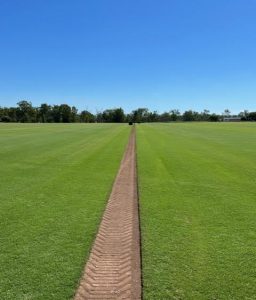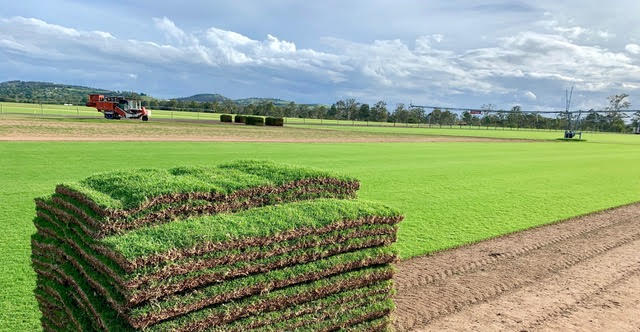Known for its durability and low maintenance, Wintergreen Couch is the go-to variety across South East Queensland, and for good reason! Cultivated for the South East Queensland climate, Wintergreen is a drought-resistant turf, able to adapt to a variety of soil conditions. It recovers quickly from the high temperatures we experience in Queensland and is a true Godsend for our harsh weather.
But don’t take our word for it, Wintergreen is all around. We see it in backyards, on sporting fields, and in parks and it is a popular choice for council landscaping.
If you’re looking for a hardy, drought-resistant, soft turf that’s perfect for the whole family, Wintergreen is a great option!
What does the turf look like?
Wintergreen is a bright green turf with a medium to fine blade leaf making it a soft and luscious turf variety for underfoot. It keeps its colour throughout summer and has good colour retention throughout winter as well so you can show off your lawn all year long.

Post-installation tips for your new Wintergreen lawn
Turf is a long-term investment, and the first few months are crucial in making sure it lasts. Once laid, you may be tempted to sit back and admire the new lawn, but the work is not done. There are important post-installation steps that you should take to ensure your turf establishes well and stays strong and healthy for many years to come.
How long will my Wintergreen turf take to establish?
Wintergreen turf will take about two to three weeks to establish, depending on the season. It can be laid year-round with great success but will establish more slowly in the cooler months, taking up to five weeks. On the plus side, when laying your new lawn in cooler weather it will require less water.
To check if your turf has “taken”, simply lift up a corner of a slab. If there are roots attaching it to the ground, your turf has “taken”.
In the first few weeks, try to keep traffic to a minimum to help your turf along. It may be worthwhile planning ahead for this. Consider laying your turf outside of school holidays and away from events in which you may want to use your lawn.

How do I care for my new Wintergreen lawn? Follow these three basic steps…
1. WATER, WATER, WATER
GOLDEN RULE: Until your turf is established, keep the soil moist! If left to dry out, your lawn will be unable to establish a strong root system and will be vulnerable in hot and dry weather.
In the first week, water your turf every morning and evening. At these times of the day, water is less likely to be wasted through evaporation and your turf can benefit from every drop.
In the second week, you can decrease the watering regime to only once a day – morning is best – and in week three, watering a couple of mornings of the week is sufficient.
Once your lawn is established, a deep water 1-2 times a week will ensure it stays strong, vibrant and healthy.
SIGNS OF OVERWATERING AND UNDERWATERING
If you notice runoff from your watering into other parts of the garden this is a clear sign of overwatering, and it is time to cut back. Other signs your turf may be too moist are squishy soil, an increase in bugs, weed growth and wilted leaves.
You know that you are underwatering if your turf begins to change colour, turning brittle and brown. You may also notice leaves changing shape and curling inward.
Keep an eye out for these signs and adjust accordingly.
NOTE: Your turf will dry out very quickly if you’re planting in our Queensland summer. Watering is critical. Obviously, rain is wonderful! Less watering will be needed.
2. MOW
Start mowing your lawn as soon as your turf has taken (approximately 2-3 weeks). By this point, the blades should be 5-7cm long. This first mow is vitally important, and timing is essential. If mowed too early, the root system of your new lawn may be damaged and if left too late, the longer grass becomes susceptible to weeds and disease.
Ensure your mower deck is on a high setting for the first mow so that your lawn is not scalped.
Once established, Wintergreen may be mowed short — the optimum height is 20-30mm. As a summer grass, when Wintergreen is left to grow longer, the root system becomes shaded causing distress, so make sure to mow regularly.
Keep your mower blades sharp to avoid ripped and frayed grass blades which leave your lawn looking uneven.
3. FERTILISE
Once established, fertilise in each season with a quality, organic lawn fertiliser to keep your lawn lush, healthy and resistant to disease. See our blog on fertilising your lawn for some guidance on the right fertiliser for your lawn.
Fertilising is best done in climates where your turf is unstressed and able to fully benefit from the chemical boost. The optimal times for fertilising are:
- Early spring
- Early summer
- Late summer
Be accurate with your application rate.
Still have a question? Need some more advice? Don’t hesitate to give us a call, we’d love to help!

